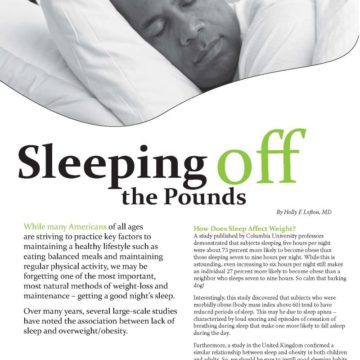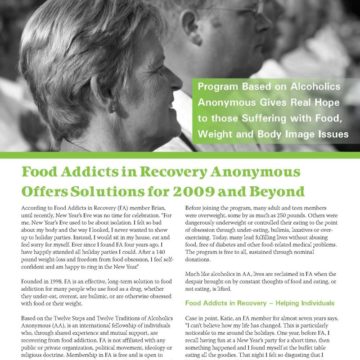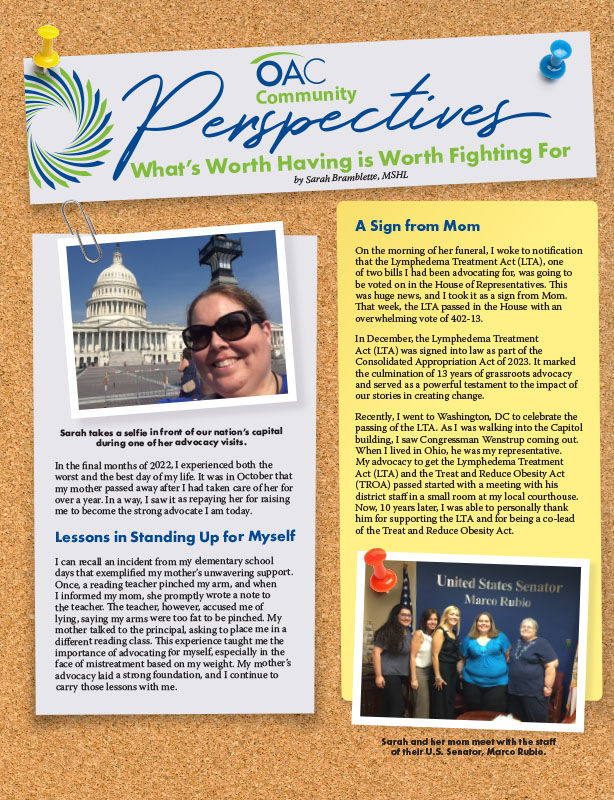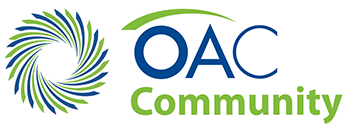The National Diabetes Goal: Turning the Tide of Pre-diabetes in America

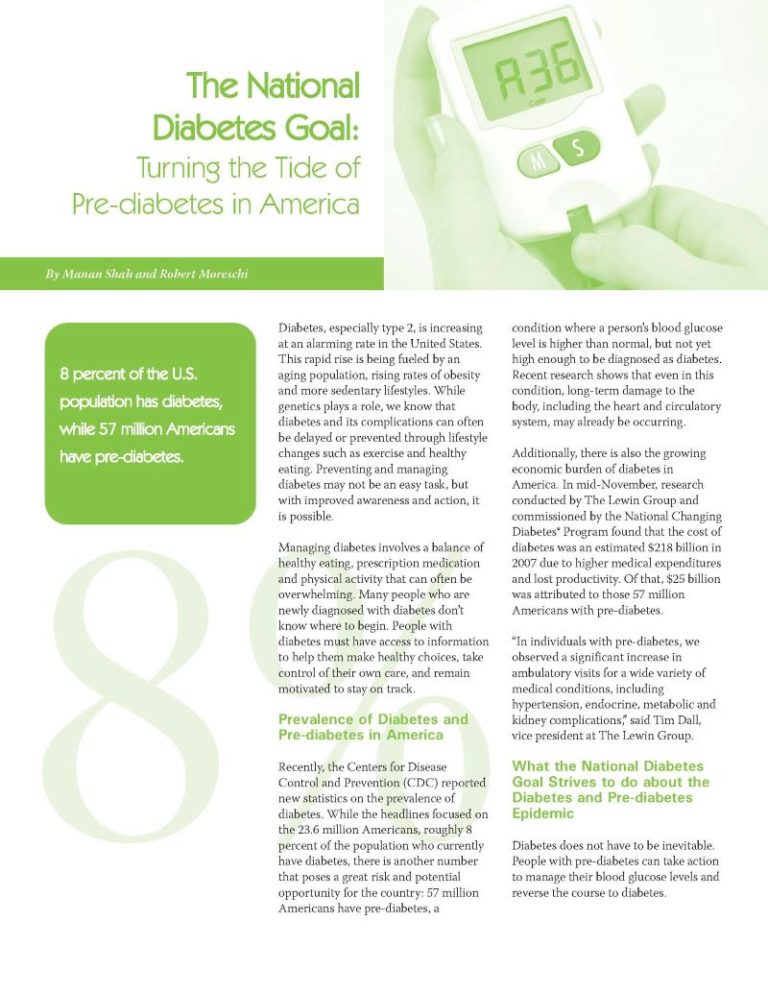
By Manan Shah and Robert Moreschi
Winter 2009
What is the National Diabetes Goal? By 2015, 45 percent of Americans who are at risk for diabetes will know their blood glucose level and what actions to take. 8 percent of the U.S. population has diabetes, while 57 million Americans have pre-diabetes.
Diabetes, especially type 2, is increasing at an alarming rate in the United States. This rapid rise is being fueled by an aging population, rising rates of obesity and more sedentary lifestyles. While genetics plays a role, we know that diabetes and its complications can often be delayed or prevented through lifestyle changes such as exercise and healthy eating. Preventing and managing diabetes may not be an easy task, but with improved awareness and action, it is possible.
Managing diabetes involves a balance of healthy eating, prescription medication and physical activity that can often be overwhelming. Many people who are newly diagnosed with diabetes don’t know where to begin. People with diabetes must have access to information to help them make healthy choices, take control of their own care, and remain motivated to stay on track.
Prevalence of Diabetes and Pre-diabetes in America
Recently, the Centers for Disease Control and Prevention (CDC) reported new statistics on the prevalence of diabetes. While the headlines focused on the 23.6 million Americans, roughly 8 percent of the population who currently have diabetes, there is another number that poses a great risk and potential opportunity for the country: 57 million Americans have pre-diabetes, a condition where a person’s blood glucose level is higher than normal, but not yet high enough to be diagnosed as diabetes. Recent research shows that even in this condition, long-term damage to the body, including the heart and circulatory system, may already be occurring.
Additionally, there is also the growing economic burden of diabetes in America. In mid-November, research conducted by The Lewin Group and commissioned by the National Changing Diabetes® Program found that the cost of diabetes was an estimated $218 billion in 2007 due to higher medical expenditures and lost productivity. Of that, $25 billion was attributed to those 57 million Americans with pre-diabetes.
“In individuals with pre-diabetes, we observed a significant increase in ambulatory visits for a wide variety of medical conditions, including hypertension, endocrine, metabolic and kidney complications,” said Tim Dall, vice president at The Lewin Group.
What the National Diabetes Goal Strives to do about the Diabetes and Pre-diabetes Epidemic
Diabetes does not have to be inevitable. People with pre-diabetes can take action to manage their blood glucose levels and reverse the course to diabetes. That is why the National Diabetes Goal was established. The need for a National Diabetes Goal was highlighted in 2008 by the results of a Gallup survey funded by Novo Nordisk, titled Public Knowledge, Perceptions and Behavior Regarding Diabetes and Diabetes Prevention: A Societal Barometer. This survey brought to light the public’s perception of diabetes and the amount of knowledge about the disease that exists among the general population.
Almost all survey respondents (94 percent) considered diabetes to be a serious health issue. The poll showed that one in four adults (24 percent) have either been diagnosed by a physician as having diabetes (9 percent) or as being at-risk for diabetes (15 percent).
The survey results revealed that high awareness about diabetes had not yet translated into action to prevent the disease, and it was this fact that led a coalition of diabetes stakeholders to develop the National Diabetes Goal: By 2015, 45 percent of American who are at risk for diabetes will know their blood glucose level and what actions to take.
In addition to calling on the American public to learn about the consequences of uncontrolled diabetes and the importance of being tested, the National Diabetes Goal emphasizes action. Blood glucose testing is only the first step in preventing diabetes; people who are at risk must also educate themselves on what the test results mean, and take the necessary next steps to stay in control of their health.
Risk Factors Associated with Type 2 Diabetes
The American Diabetes Association identifies several risk factors associated with type 2 diabetes. They include a family history of diabetes or heart disease, being affected by excess weight or obesity, being physically inactive and having high blood pressure or triglycerides or low HDL cholesterol. African Americans, Hispanics, Native Americans, Asian Americans and Pacific Islanders are also at higher risk for developing diabetes.
Confirming the important role that family history and genetics play in diabetes, a recent report in the Journal of the American Medical Association1 estimates that one in three boys and two in five girls born in the year 2000 are at risk to develop diabetes in their lifetime; this number increases to one in two for minority children born that year. Diabetes is more common in African Americans, Latinos, Native Americans and Asian Americans/Pacific Islanders. This means these groups are also at increased risk for developing pre-diabetes.
Currently, the Goal is championed by the Obesity Action Coalition and more than 45 other health, advocacy, business and educational organizations across the country that are committed to reversing the diabetes epidemic in the United States.
Partnering Together
Some recent activities that these champions have taken to advance the National Diabetes Goal include the following:
- Bellwether Medical Center in Washington, Barton HealthCare System in California and the University of Missouri-Kansas City hosted multiple diabetes screening events in their local communities. Community members attended to learn about risk factors for diabetes and to get screened for the disease.
- The National Association of School Nurses has integrated Goal material into a variety of its programs, including School Nurse Childhood Obesity Prevention Education (S.C.O.P.E.), a training program for over 13,000 school nurses across the country.
Each organization that supports the National Diabetes Goal is working to reach out to its audience and constituents to spread the message of diabetes awareness and action. If you are interested in supporting the National Diabetes Goal or would like to learn more information about this initiative, visit www.NationalDiabetesGoal.com.
About the Authors:
Manan Shah is with the National Changing Diabetes Program and works on the National Diabetes Goal as well as the National Clinical Barometer, a project to analyze the current diabetes quality measurements in the United States. A graduate of American University, he is an avid runner and political writer.
Rob Moreschi recently joined the National Changing Diabetes Program (NCDP) and works on the NCDP newsletter as well as the National Diabetes Goal. Currently a senior at Rutgers University, he enjoys writing and is focusing on media and communications within the health care industry.
References:
12 K. M. Venkat Narayan, et. al. Lifetime Risk for Diabetes Mellitus in the United States. JAMA, Oct 2003; 290: 1884 – 1890.
by Sarah Ro, MD; and Young Whang, MD, PhD Fall 2023 Mary, a postmenopausal woman with a…
Read Articleby Rachel Engelhart, RD; Kelly Donahue, PhD; and Renu Mansukhani, MD Summer 2023 Welcome to the first…
Read Articleby Sarah Bramblette, MSHL Summer 2023 In the final months of 2022, I experienced both the worst…
Read Article




